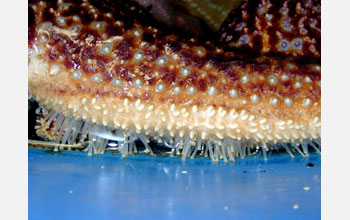Multimedia Gallery
Marine Life of California's Rocky Shores (Image 27)
The tube feet of a sea star. The sea star's preference for shellfish is because they are uniquely adapted to hold onto solid shell with hundreds of sucker-tipped tube feet that are found under each leg. These are controlled by water pressure that enters the sea star through a special sieve plate, called a madreporite, on the upper surface of its body.
The tube feet can pull two pieces of shell apart for hours (or days, if needed) until their prey tires. Sea stars never tire of pulling open a shellfish because they have hundreds of tube feet - always resting a few. Once there is the tiniest crack (a tenth of a millimeter is all that is needed) the stomach of the sea star can emerge, ooze into the crack and digest the prey. In general, it takes more than six hours to consume a mussel. The upper limit of where sea stars prey on their favorite food, the mussel, is 2.5 feet above sea level because the rocky shore dries out every six hours when you get higher than this (the High Tide Zone) and sea stars do not tolerate that much dryness. [Image 27 in a series. See Image 28.]
More about this Series
This series of images examines the various marine life that can be found in the different sea levels, or zones, of the rocky shores of the California coast. The images were photographed by Genevieve (Genny) Anderson of the biological sciences department, Santa Barbara City College, as part of her ongoing research on the subject.
Rocky shores provide a stable substrate for plant and animal life or organisms, as opposed to sandy beaches where the substrate (sand) is constantly moving. When the tide goes out then the influences of the air and weather (sun, rain, snow) begin to play important roles--more with the higher zones.
At any tide level on a rocky shore, a pool of water--called tidepools--can be left with the receding tide. These pools provide welcome ocean water for marine life left high and dry with a receding tide. The pools highest in the intertidal may become very hot due to the sun which may not be comfortable for some species. The pools closest to the low tide have the least influence from the air and weather and thus the greatest variety of marine life. These tidepools often mirror what is actually subtidal (below the lowest low tide, as opposed to intertidal which is between the tides). As the water goes down, most of the ocean creatures go out with it, but some can't move and are left on rocks. These creatures must be adapted to withstand not only the dryness of their area, but waves, storms, wind and rain. It is their ability to withstand dryness, and their interactions with each other (eating, being eaten, competing for space and reproducing) that determine who dominates within the rocky intertidal areas.
In examining the marine life of the exposed rocky surfaces of California's shores, it is easiest to look at these rocky surfaces where they live in "zones." Above five feet, the surface is covered only by the highest high tide and thus dry three-quarters of the day. This is called the "Splash" Zone. Then, between five feet and two and a half feet, the surface is covered alternately by both high tides so it is dry between the high tides--about half a day. This band is called the "High Tide" Zone. Between sea level and two and a half feet the rocks are only left dry at the low, low tide. This area is thus dry only a quarter of each average day and called the "Mid Tide" Zone. Then there is what we call the "Low Tide" Zone, the area below sea level that is exposed for only a few hours every few weeks at special "minus" tides (remember, zero sea level is the average of the low, low tides).
To learn more about Genevieve (Genny) Anderson's research on marine life along California's rocky shores, visit her Web page, "California Tidepools (Rocky Shores)." Anderson, who has been a teacher of marine biology and biological oceanography at Santa Barbara City College for over 30 years, has other interesting lesson plans and lecture material available on her website, Here.
Credit: Genny Anderson, Santa Barbara City College
Images and other media in the National Science Foundation Multimedia Gallery are available for use in print and electronic material by NSF employees, members of the media, university staff, teachers and the general public. All media in the gallery are intended for personal, educational and nonprofit/non-commercial use only.
Images credited to the National Science Foundation, a federal agency, are in the public domain. The images were created by employees of the United States Government as part of their official duties or prepared by contractors as "works for hire" for NSF. You may freely use NSF-credited images and, at your discretion, credit NSF with a "Courtesy: National Science Foundation" notation.
Additional information about general usage can be found in Conditions.
Also Available:
Download the high-resolution JPG version of the image. (356 KB)
Use your mouse to right-click (Mac users may need to Ctrl-click) the link above and choose the option that will save the file or target to your computer.

